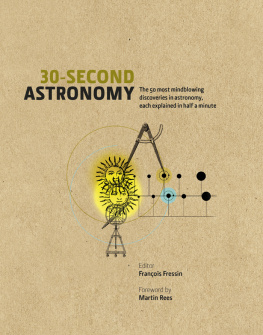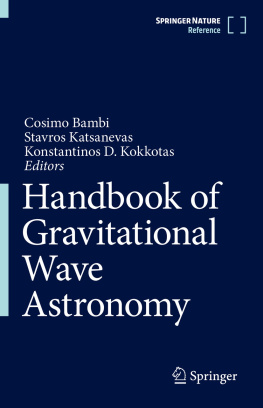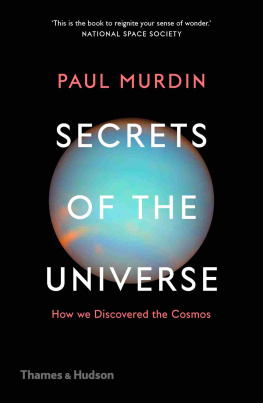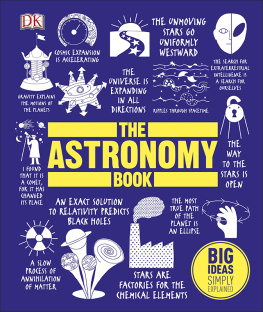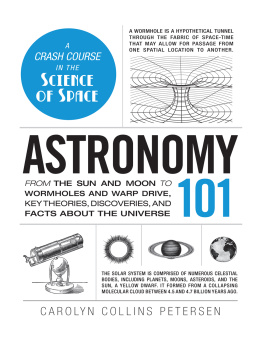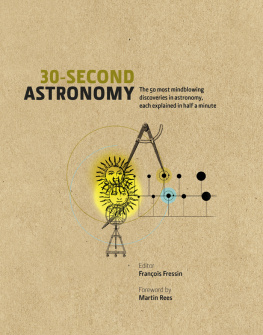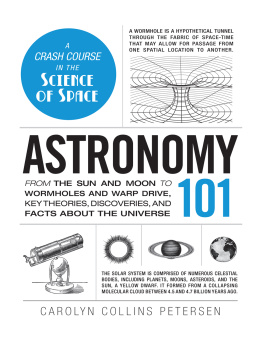
30-SECOND
ASTRONOMY
The 50 most mindblowing discoveries in astronomy, each explained in half a minute
Editor
Franois Fressin
Foreword by
Martin Rees
Contributors
Darren Baskill
Zachory K. Berta
Carolin Crawford
Andy Fabian
Franois Fressin
Paul Murdin

First published in the UK in 2013 by
Icon Books
Omnibus Business Centre
3941 North Road
London N7 9DP
email:
www.iconbooks.net
2013 by Ivy Press Limited
The editor and contributors
have asserted their moral rights.
No part of this book may be reproduced
in any form, or by any means, without
prior permission in writing from
the publisher.
This book was conceived,
designed and produced by
Ivy Press
210 High Street, Lewes,
East Sussex BN7 2NS, UK
www.ivypress.co.uk
Creative Director Peter Bridgewater
Publisher Jason Hook
Editorial Director Caroline Earle
Art Director Michael Whitehead
Designer Ginny Zeal
Illustrator Ivan Hissey
Profiles Text Viv Croot
Glossaries Text Charles Phillips
Project Editor Stephanie Evans
ISBN: 978-1-84831-597-6
Colour origination by
Ivy Press Reprographics
10 9 8 7 6 5 4 3 2 1
CONTENTS
FOREWORD
Martin Rees
The night sky is the most universal part of our environment. Throughout history, people have gazed up at the same vault of heaven, though each culture has interpreted it in its own way. Ever since the Babylonians, patterns have been recorded in planetary motions. The need for a precise calendar, and for navigation across the oceans, has motivated advances in timekeeping, optics and mathematics. Indeed, astronomy has always been a driver for technology. And, thanks to huge telescopes, probes and advanced computers, modern astronomers have discovered the amazing cosmic panorama described in this book.
Theorists like myself lag far behind in trying to make sense of it all. But we have made progress. We can trace cosmic history back to a mysterious beginning nearly 14 billion years ago, when everything was squeezed hotter and denser than anything that can be created in a laboratory; we understand in outline how the first atoms, stars and galaxies emerged. We realize that our Sun is a typical star among the billions in our Galaxy; and that our Galaxy is just one of many billions visible through a large telescope. Moreover, some theorists speculate that a further Copernican demotion may lie ahead: physical reality is almost certainly more extensive than the domain we can observe; indeed our Big Bang could be just one of many.
But recent advances havent just extended our cosmic horizons: they have revealed richer detail. Probes to other planets of our solar system (and their moons) have beamed back images of varied and distinctive worlds. More important still, weve inferred, by detecting very slight changes in the motions and brightness of stars, that most of them are orbited by retinues of planets, just as the Earth and other familiar planets orbit the Sun. In coming years, we will be swamped by fascinating new data perhaps even evidence of life around other stars.
Astronomy now attracts wider interest than ever before its discoveries are part of modern culture. Moreover, the joy of discovery isnt now limited to professionals indeed they are swamped by the sheer quantity of data. So there is scope for citizen scientists, who can access and download data from surveys made with the worlds best telescopes, and perhaps discover a new galaxy or a new planet. And serious amateurs, using small telescopes with the latest instrumentation, can match what professionals with much larger telescopes could do 50 years ago.

Our brightest neighbour
Planet Venus is very visible, partly because sunlight is easily reflected by the sulphurous clouds that blanket its atmosphere. Venus is the closest planet to our Earth, within reach of questing space probes, although its hot, deadly atmosphere prohibits any human exploration of its surface.
The technical details of all modern science are arcane. However, I believe that the essence of any discovery can be conveyed in accessible language. To condense a concept into 30 seconds is a bigger challenge, but one that has been triumphantly met by the authors here.
This book deserves wide readership among those fascinated by the extraordinary zoo of objects in the cosmos a cosmos governed by physical laws that allowed creatures to evolve (on Earth and perhaps on alien worlds too) with minds able to ponder its wonder and its mystery.
INTRODUCTION
Franois Fressin
Almost every discovery about the Universe has led us to realize how insignificant the Earth is. Compared to the rest of the Universe, our Earth represents roughly as much as a drop of water in the oceans, or a grain of sand in the deserts. In almost every field of research, astronomers have been surprised both by the extent of astrophysical structures and by their diversity.
But astronomical discoveries also tell us how strongly we are connected with the cosmos. We learn about the solar system, and we appreciate the interplay of its constituent parts with the appearance of life on Earth and its evolution. Comets brought the vast quantity of water that formed our oceans. The Moon slowed the Earths rotation and is responsible for the tides and the seasons. Jupiter scattered asteroids that would otherwise dramatically impact on the Earth. Our connection to the stars is even stronger. The air we breathe, the iron in our blood, the carbon in our flesh; all of these came from the core of a dying star, billions of years ago.

Giant planets
Despite their size, the very existence of Uranus and Neptune was unknown to astronomers prior to the invention of the telescope.
Astronomy has this strange duality between insignificance and preciousness. A human life is so close to nothing in the immensity of space and the passage of ages. But nowhere and never has there existed someone exactly like you. If we define spirituality as an inner path enabling a person to discover the essence of his or her being, then astronomy is definitely a spiritual experience.
The topics in this book will give you an idea of this barely imaginable immensity and diversity. Unicorns, psychic powers, flying cities are fairly easy to picture. How about objects so massive that they distort space and time, a dark energy scattering the entire Universe apart? How about the fact that the breadth of your finger, held up to the sky, covers millions of galaxies, each one containing billions of stars like the Sun, or the fact that you are standing on a ball of mud that will endlessly fly through the void? Any one of those scenarios is a little tougher to imagine, but they all reflect the real world.
Next page
